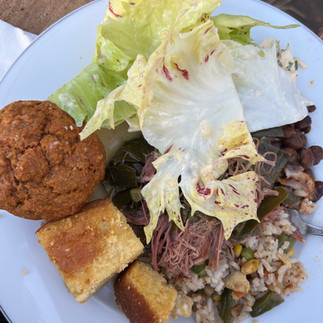Blue Raven Farm Tour
- Laura Bennett
- Dec 7, 2022
- 6 min read
Longtime farmer and soil ecology expert, Jen Aron, led a group of fellow farmers around her established no-till CSA farm on a beautiful sunny day in November.

The drive out to Blue Raven is full of twists and turns along the Sandy river, a rather "over the river and through the woods" commute. At 700 feet elevation, once you turn into the trees and wind your way down the gravel drive, you go deeper and deeper until suddenly you come upon a stunning little no-till masterpiece in the middle of the woods.
"Where are all the weeds?"
A farmer immediately asked this question when we walked out into Jen's veg production field. She gets that question a lot, she says, adding, "We do have weeds, we just don't have weed pressure."

To many, this photo may just look like a bed of beets. But to a farmer, this is art. We stood over the bed in awe and Jen said something we did not expect: "This planting has never been weeded." Quite the mic drop in the farming world. How could that be? Where are the thistles to bite at your fingers and rip holes in the beet greens? Where is the pigweed and grass growing tall enough tickle your nose as you harvest?
Decreased weed pressure is one of many benefits of a no-till system. In addition to an orchard, Blue Raven has a half acre of intensive vegetable production that Jen maintains almost entirely by herself. That's partly possible because she estimates that she spends less than fifteen minutes per week weeding.
Jen explained that the near absence of weeds is a result of many different factors. "It's all about the biology," she said. The act of tilling not only wakes up old banks of weed seeds that were sleeping in the soil, bringing them to the surface where they can all germinate, but it changes the soil biology itself to create a weed's dream soilscape.

With a quick crash course on soil biology, Jen explained that the act of tilling kills a lot of soil critters, such as fungi, protozoa, and various bacteria, leaving a rather blank substrate for specific bacteria to take over, and those particular bacteria produce a nitrate that newly germinated weeds just slurp up. A healthy soil with diverse biology contains more fungi, for example, which produce compounds weeds don't enjoy.
From "Farming by the Book" to No-Till

Jen ran an educational farm for Oregon State University for many years, and was "farming by the book." After a few years, she noticed that production was decreasing, and there was some "new weed, new pest, new disease, every year." She continued to farm with OSU while she started Blue Raven, and with her passion for soil, she began to dig deeper into other ways of going about this farming game.
"The land was rough," she explained. When she got there seven years ago, the land had been logged and there was garbage strewn about. Her first season after breaking ground was inundated with pests and weeds, yet she also said, "we didn't even have enough pollinators to pollinate our winter squash."
"Our first five years was basically to see if no-till was even possible in the Pacific Northwest." At that point in time, the no-till movement relied heavily on chemical herbicides to get rid of the initial weed bursts. She said it did require a decent amount of upfront labor to clear the fields. She also had to plant plenty of crimson clover to attract more pollinators. Little by little, there was "so much life and diversity, and it happened very quickly."
A Love Story with the Soil

It goes without saying, Jen is really into soil. She didn't grow up farming and says she just felt such a strong pull toward the soil and wanted to play a role in helping others connect with the soil as well. The way she speaks about the soil is as if she's speaking about a good old friend. "We don't consider ourselves owners, we are stewards of this land."
She's written for Growing for Market Magazine and has educated countless interns and fellow farmers on all things soil ecology. When we first arrived and we were all introducing ourselves in the parking lot, once she started talking about soil ecology, a huge smile spread across her face as she said, "I even brought out some visual aids!"
It wasn't until later in the day we were introduced to Penny the Penetrometer. Penny is Jen's trusty farming partner. Penetrometers are a fairly simple tool that you use to stick into the soil and measure its compaction and depth. She says a lot of us think we can just stick our finger into the soil and know what's going on down there (guilty!), but it's important to remember that our fingers are very different than roots!
Plant roots can exert 200 PSI of force, but she says she aims for the soil to require no more than 150 PSI for roots to penetrate. "Soil aggregates are like the ball pit at Chucky Cheese!" she explained, the roots can go straight down through well aggregated soil. "It's all about Penny," she said. "Penny rules this farm."
"It's not about no weeds, no pests, no disease, it's about balance."

No-till farming doesn't just help keep the weeds in balance, "it allows the soil to maintain itself." The 2022 growing season was such a wet spring in particular. Plants on many farms were stunted in cold, wet soils, going to seed before they ever even grew. But Blue Raven did just fine! "We had an epic year," Jen said, "even with the spring we had, likely due to soil health."
For example, in Oregon we have a lot of rain that falls on our soil and can affect its pH. Soil pH has to be just right for plants to be able to access nutrients in the soil, so to keep the pH balanced most farms have to apply lime or some other alkaline compound once or twice a year. Jen's soil has only received one application of lime and has worked itself from a pH of 4.8 to 6.7. And that's even with her location receiving up to 60-80 inches of rain a year! That's a lot of water.

In addition to the decreased weed and pest pressure, inputs such as lime, fertilizer, and compost are also extremely minimal compared to most other small-scale systems. Another absolutely incredible benefit of the well-balanced ecosystem at Blue Raven is the decreased disease pressure.
Hoop house space on farms is always limited, and having to comply with proper crop rotation to prevent disease outbreaks within that limited space is always a challenge. Yet as we gathered around Jen's hoop house, she explained that she can actually plant tomatoes in the same beds year after year. The soil mitigates disease pressure for you.
"The less we mess with our soil and leave it alone, the better it gets."

"There's a lot of avenues to good soil health," Jen explained, "I just try to be as minimal as we can." She says that she thinks of Blue Raven as a research farm since there really is no one way to do something. You have to learn what your landscape and your soil needs and she loves to encourage others to do trials on their farms as well.
Not only has Jen helped empower so many farmers to try out different practices on their farms, she sort of empowers the soil itself to act with its own agency in the farming system. She doesn't farm the land, she farms with the soil as a team, as a member of the ecosystem itself.
Blue Raven offers a year-round CSA that goes bi-weekly during the winter. To learn more about Jen and her no-till farming practices, head to her website at https://www.blueravenfarm.org/.

It was a pleasure to walk around Jen's farm in the sunshine, and an absolute joy to get to do it with a group of fellow farmers. These farm tours are a great way for farmers to connect with each other, learn from each other, and share a potluck meal together. If you're a farmer in the Pacific Northwest, follow us on social media @pnwcsa to hear more about our upcoming farm tours!




























Comments